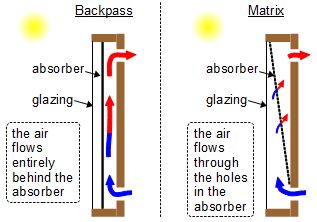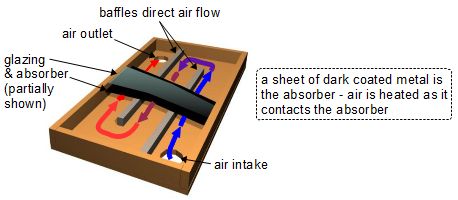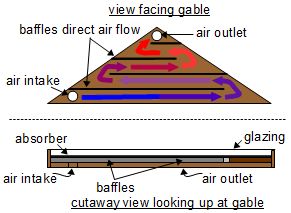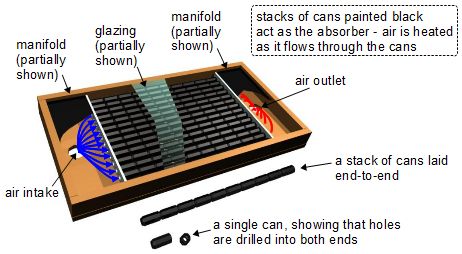Types of DIY/homemade solar air heater
The main types of DIY/homemade solar air heaters
A recent growth of activity in the DIY community has lead to the classifying of solar air heaters into ether backpass or matrix solar air heaters.

Backpass solar air heater
A backpass solar air heater is one where the air to be heated flows entirely behind the absorber. The air takes heat from the absorber largely by conduction as the air makes contact with the absorber. As well, air that doesn't make contact with the absorber takes heat from air that does.
Specific variations of these discussed below are the:
Matrix solar air heater
A matrix solar air heater is one where the air passes through holes in the absorber as the air flows from in front of the absorber to behind it. The air takes heat from the absorber mostly as it passes through the holes, though it may also take heat from both the front and back of the absorber and from contact with already heated air.
Specific variations of these discussed below are the:
In the DIY community is was previously assumed that the backpass type was more efficient than a matrix type but recent experiments by two members of the SimplySolar yahoogroup, Scott and Gary, have tentatively shown that the screen solar air heater, a matrix type, may be more efficient.
Beware of solar air heaters that cover most or all of a window. See this page about window covering solar air heaters for more about this.
Backpass with baffles (backpass)
This is basically a box with a dark metal plate behind which the air flows. The plate is painted black and acts as the absorber. Baffles, or air guides, are placed behind the absorber in order to increase the length of the path for the air to flow, increasing the chance for the air to make contact with the inner surface of the absorber to take heat from it. On the left below is a simple rectangular solar air heater.


The diagram on the right above shows that a baffle backpass lends itself well to odd shapes, such as a gable. The point here is that the airflow is mostly even since there is only a single airpath. There may be some pockets of still air at the ends but that's a small part of the overall length.
Can solar air heater (backpass)
This type was inspired by the commercial solar air heater, Cansolair, which uses recycled aluminium soda/beer cans stacked end-to-end to create long tubes for the air to flow through. The cans are painted black and act as the absorber. A lot of DIYers make this type, probably due to the abundent supply of cans and the 'coolness' of the approach.

It's thought that the hole made where two cans meet causes turbulance in the air flow and makes more of the air contact the inner surface of the cans and therefore take more heat from the cans resulting in increased efficiency.
Downspout solar air heater (backpass)
The downspout literally makes use of downspouts, the same ones normally used to channel water from eavestroughing from a roof's edge down to the ground. The downspout acts as the absorber. Just as with the can solar air heater, the air flows inside the downspout taking heat from the inner surface as it makes contact with it.
One of the nice things about this type is that it's easy to make a long, low profile solar air heater suitable for putting at ground level at the foot of a house. When comparing to the can solar air heater, simply using downspouts is a lot less work than cutting, cleaning, painting and stacking all those individual cans.

Screen solar air heater (matrix)
In this one a fine mesh screen is used as the absorber, the screen typically being made of fibreglass or aluminium. The air is heated mostly as it makes contact on its way through the small holes in the screen, going from the front of the solar air heater to the back. Two layers of screens works better than just one as the back one will also be heated by the sun and transfer its heat to the air.

To make a longer screen solar air heater the following has been shown to work well. Simply have multiple screens which overlap somewhat as shown below. The air is heated a little more as it passes through each successive screen. You'd think that the increasingly hot air contacting the glazing would add up to great losses but this does work. Perhaps the overlap of the screens helps with this, though non-overlapping ones have also been shown to work.

Soffit solar air heater (matrix)
The soffit is literally made using sheets of the soffit material normally used under roof overhangs. The soffit is painted black and acts as the absorber. This is much like the screen solar air heater except that the holes are bigger and there is much more surface area to the absorber, unlike with the screen solar air heater where the absorber is practically all holes. In this case the air is heated more from a mix of its contact when passing through the holes and from contact with the front and back surfaces of the absorber.

